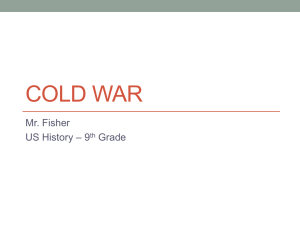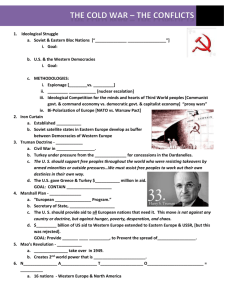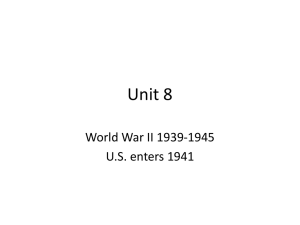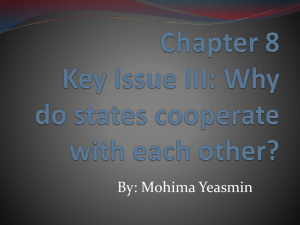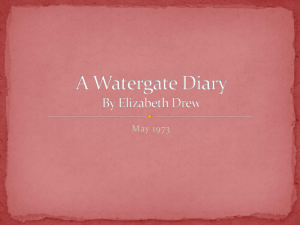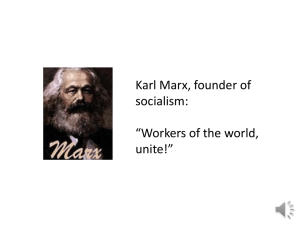STAAR REVIEW -Answer Key
advertisement
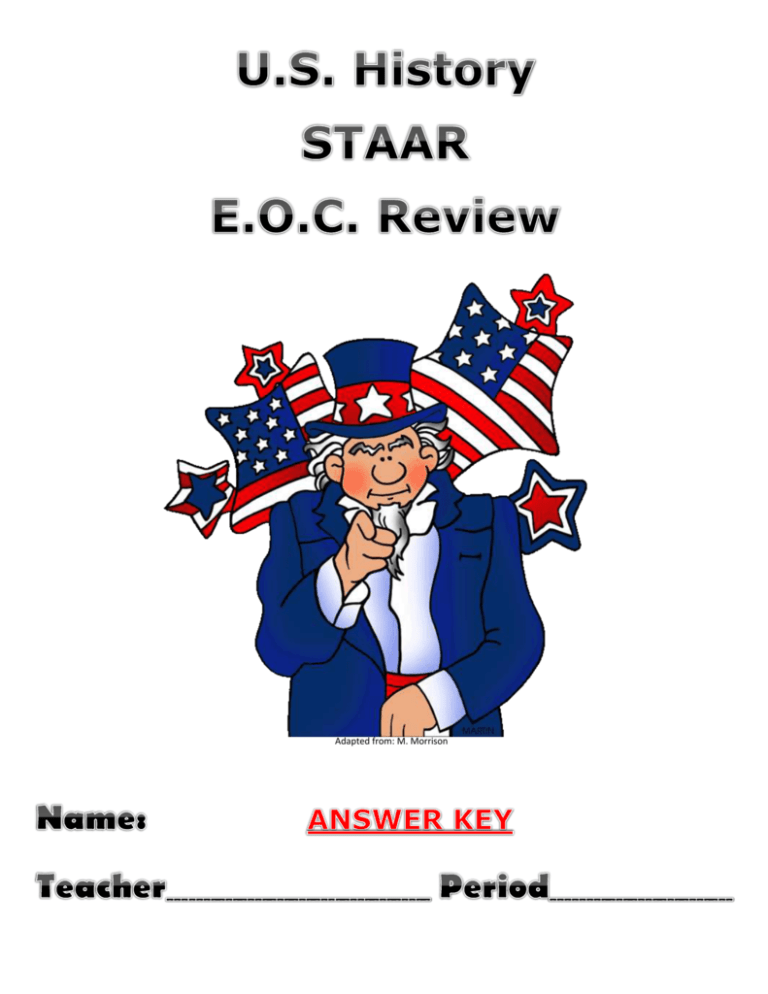
Adapted from: M. Morrison Describe with words or pictures how each of Alexis de Tocqueville’s five values are important to U.S. democracy. 3. Populism —Popular Sovereignty— People participate in political life— people rule 4. Egalitarianism 2. Individualism Free to choose Little to no government control Laissez-Faire —Free enterprise— —Equality— Society where people are equal Land ownership Social equals Alexis de Tocqueville said these values are crucial to America’s success. Individual controls own interests No government control over economy 5. Liberty Freedom No overly controlling gov’t Rule of law Then, what is the importance of Democratic Process—Civic Responsibility? “Building a More Perfect Union” Lobbying: attempt to influence government officials Non-violent protest: means of changing injustices Litigation: resolving disputes in court Amendments: official changes made to Constitution as needed 2 Founding Fathers’ Line-up 1. Explain the significance of these Founding Fathers to the formation of the United States. Create a symbol to help you remember the last 6 people. 2. Using the twitter pages from the Moodle Review, who would these Founding Fathers follow and who would follow them? Benjamin Rush John Hancock “Father of American Medicine” who was a doctor, teacher and humanitarian who signed the Declaration of Independence. Businessman and President of the Continental Congress. Large signature on Declaration of Independence symbolized freedom. John Jay John Witherspoon Favored independence and helped negotiate a peace agreement with Britain ending the American Revolution. Minister who signed the Declaration of Independence and supported independence through education. President of John Peter Muhlenberg Charles Carroll Minister who recruited soldiers to fight against the British. Wealthy supporter of independence who financed the American Revolution. Jonathan Trumball, Sr. John Locke Governor of Connecticut who sided with the colonists against the British. English philosopher whose ideas from “Two Treatises of Government” stated that people were born with natural rights and a ruler’s power comes from the people. George Washington Thomas Jefferson Commanded the new Continental Army. Wrote most of the Declaration of Independence listing grievances against British 3 Charters of Freedom Declaration of Independence Constitution When in the Course of human events, it becomes necessary for one people to dissolve the political bands which have connected them with another, and to assume among the powers of the earth, the separate and equal station to which the Laws of Nature and of Nature's God entitle them, a decent respect to the opinions of mankind requires that they should declare the causes which impel them to the separation. We the People of the United States, in Order to form a more perfect Union, establish Justice, insure domestic Tranquility, provide for the common defense, promote the general Welfare, and secure the Blessings of Liberty to ourselves and our Posterity, do ordain and establish this Constitution for the United States of America. Bill of Rights The Conventions of a number of the States, having at the time of their adopting the Constitution, expressed a desire, in order to prevent misconstruction or abuse of its powers that further declaratory and restrictive clauses should be added. Amendment V No person shall be held to answer for a capital, or otherwise infamous crime, unless on a presentment or indictment of a Grand Jury, except in cases arising in the land or naval forces, or in the Militia, when in actual service in time of War or public danger; nor shall any person be subject for the same offence to be twice put in jeopardy of life or limb; nor shall be compelled in any criminal case to be a witness against himself, nor be deprived of life, liberty, or property, without due process of law; nor shall private property be taken for public use, without just compensation. We hold these truths to be self‐evident, that all men are created equal, that they are endowed by their Creator with certain unalienable Rights, that among these are Life, Liberty and the pursuit of Happiness.‐‐That to secure these rights, Governments are instituted among Men, deriving their just powers from the consent of the governed, ‐‐That whenever any Form of Government becomes destructive of these ends, it is the Right of the People to alter or to abolish it, and to institute new Government In your own words… ANSWERS MAY VARY Importance… ANSWERS MAY VARY In your own words… ANSWERS MAY VARY Importance… ANSWERS MAY VARY In your own words… ANSWERS MAY VARY Importance… ANSWERS MAY VARY 4 Principles of the U.S. Constitution Checks & Balances— creates a balance of power between Explain these in your own words or draw an image that reflects the meaning Protections of the Bill of Rights 1 Freedom of religion Fill in the blanks assembly 3 branches—each branch (legislative, press executive, judicial) assigned certain petition powers speech 2 right to bear arms Federalism—division of power based on 3 no quartering of troops location Federal 4 no unreasonable search State and seizure Local Separation of Powers—divides 5 government powers into 3 branches no self-incrimination no double jeopardy grand jury eminent domain. . . the government can property with just 1. legislative – law-making body take over 2. executive – executes the law compensation 3. judicial – judges the law 6 trial by jury right to a lawyer speedy trial 7 trial by jury (civil cases) 8 no cruel and unusual Popular Sovereignty—people hold the 9 rights of the people are not limited to power over government those in the Constitution Individual Rights—protected rights of 10 all powers not specified in the Constitution the people in the Bill of Rights are given to the Limited Government—government has only the powers given in the Constitution Republicanism—democratic punishment government chosen by the peoplerepresentation states 5 What was Manifest Destiny? The belief that the nation was meant to spread to the Pacific. What was the Klondike Gold Rush? Rush to the Yukon area to find gold. How did this change demographic patterns? Government encouraged Western Expansion How did mining impact western expansion? Miners would move hoping to strike it rich which spread settlement into new areas What role did ranchers play in western expansion? (cattle industry boom) Ranching caused movement of cattle to railroad lines Homestead Act: made land available to settlers. What impact did this have on settlement of the West? Opened the opportunity to settlement of the West by settlers desiring land. Railroads: What impact did the railroad industry have on settlement? Attracted settlers & business to the West through transportation connections Which Railway connected east with the west? Transcontinental Railroad Indian Wars: much conflict erupted as settlement pushed westward. What did the U.S. government do to attempt to solve the conflict? Farm Issues: List challenges of the frontier—drought, weather grasshoppers Eventual economic problems—low crop yields Barbed wire impact—conflict between farmers & ranchers Populists—3rd party movement that tried to address farmers’ problems Sent military Forced removal Treaties Explain the Dawes Act: Abolished Native American tribes by giving each family 160 acres to encourage Americanization 6 What are some characteristics of the time? POLITICAL MACHINES Who was the famous political boss of Tammany Hall, NYC? William “Boss” Tweed Corruption Bribery BUSINESS Free enterprise, laissez-faire government and abundant resources caused — growth in business Led to growth of industry / corporations / trusts / monopolies Entrepreneurs o Andrew W. Carnegie - Gospel of Wealth (philanthropy) o John Rockefeller – Standard Oil List workplace abuses—low wages, long hours, dangerous work environments, repetitive tasks o Why was this called the Gilded Age? wealth for some; poverty for others o What was Social Darwinism? competition in businessstronger would survive IMMIGRATION Push factors? poverty, war, discrimination Pull factors? freedom, jobs, opportunity New immigrants from southern/eastern Europe What was nativism? viewpoint that wanted to restrict immigration Chinese Exclusion Act (1882)—What was the economic impact? restricted immigration of Chinese workers Social Gospel – Christian value that motivated social reform efforts (ex. Salvation Army) URBANIZATION Rural to urban-Why did people move? Rapid growth brought problems: o Overcrowding o Sanitation problems o Tenements o Infrastructure o Corruption TECHNOLOGY Elevator Telephone/telegraph Oil drilling Bessemer Process Electricity How did technology impact business? improved productivity and standard of living 7 Instructions: Trace the problems to the reform and then explain the impact. Progressive Era Muckraker Problem Economic Reform Business regulation: o Interstate Commerce Act o Sherman Anti-Trust Act o Clayton Anti-Trust Federal Reserve Act 1913—Established the Federal Reserve System to help with economic issues Woodrow Wilson 16th Amendment—Income Tax Ida B. Wells W.E.B. DuBois Elizabeth Cady NAACP 19th Amendment Moved nation toward equality based on gender Settlement houses Movement toward social reform Lincoln Steffens Robert LaFollette Initiative—voters can introduce bill Recall—voters can remove elected officials Referendum—voters could seek legislators to put a bill on a ballot Direct Primary—used by voters to choose candidates 17th Amendment—direct elec. of senators Civil Service Reform— testing to make sure Ida Tarbell 1. Monopolies/trusts Theodore Roosevelt 2. Banks 3. Laissez-faire government Social 1. Civil Rights 2. Suffrage 3. Working conditions 4. Living conditions Stanton Susan B. Anthony Jane Addams, Jacob Riis Booker T. Washington 5. Consumer safety Upton Sinclair wrote —The Jungle Political 1. Government corruption 2. Amendments Environment 1. Abuse of natural resources What impact did the reform have? Teddy Roosevelt John Muir Education Meat Inspection Act Pure Food and Drug Act Labor Unions — AFL, Knights of Labor qualified people get govt. jobs National Park Service Act—established parks & monuments under federal control National Park System—supervision & maintenance of natural parks, monuments Increased the federal government’s ability to prevent unfair business activities Federal government’s movement toward enacting monetary policy Congress could now tax personal income Gave a voice to racial equality Protection of consumer health Gave a voice to workers’ rights Helped end corruption and increased participation in democratic process Conservation of natural resources by the federal government 8 American Imperialism From Isolationism to Expansionism Why? Examples: Military Annexation of Hawaii o Alfred T. Mahan argued for a strong o Sandford B. Dole o Missionaries Navy in his book “Influence of Sea Power Upon History” o Protection of territories o Refueling ports o Increase trade Economic/Political o Need for raw materials and o o o o markets. Open Door Policy— U.S. declares continued trade with China. Boxer Rebellion Dollar Diplomacy— Taft’s idea to give economic support to other countries. Roosevelt Corollary of the Monroe Doctrine— justified sending U.S. troops to intervene in Central America. Social o Spread of American institutions o Missionary zeal White Man’s Burden o Military Port Commodore Perry opens Japan to trade Henry Cabot Lodge and Theodore Roosevelt pushed for expansionism— what is that? Desire to expand territory for economic, social, or political gain How was this different from previous U.S. foreign policy? Isolationism was original foreign policy (neutrality) Panama Canal o Huge undertaking that Theodore Roosevelt oversaw o Improved trade and military movement o Malaria/challenges of geography Think About It: How did these events move the U.S. into the position as a world power? Social, economic and political motives in addition to acquiring territory moved the U.S. as world power. 9 Who? U.S. vs. Spain When? Where? 1898 Havana, Cuba USS Maine is sent to Cuba to San Juan Hill Victory of Rough Riders led by Theodore Roosevelt Philippines protect U.S. interests Yellow journalism—Pulitzer and Hearst newspapers used this exaggerated form of journalism Explodes and seen as an attack on the U.S. Spanish American War Review this short war and its impact by filling in the blanks Why? USS Maine sinks and How? Media— Yellow journalism increases support Land— U.S. fought Spain in Cuba and the Phillipines the U.S. blames Spain DéLome letter calls President McKinley weak. Americans are outraged __________________________ Sea— U.S. defeats Spain quickly Significance U.S. acquired territory from Spain—Guam, Puerto Rico, and Philippines Platt Amendment— U.S. could intervene in Cuba What was the result? U.S. moves into world power Why is this war considered a turning point? U.S. began to have more international influence 10 Who? President Wilson initially declared Poison gas neutrality Alliances: Tanks Allies vs. Central Powers American Expeditionary Forces Effects of Technological Innovations Technological Innovations? (AEF) led by John J. Pershing Argonne Forest one of the most famous battles (1918)because it shattered the German defenses Alvin York won the Congressional Medal of Honor Western Front— hundreds of miles of battle front along eastern France Trench warfare … led to a Machine guns Stalemate led to … Airplanes Massive casualties When? 1914-1918 Another Turning Journalism—Pulitzer and Hurst Point! newspapers used this exaggerated World War I—Why is this a Turning Point? form of journalism Causes? Militarism: Alliances: Imperialism Nationalism: build-up of military joining forces with countries with similar ideology exercising control over another nation extreme loyalty to your nation Assassination of — Reasons for United States Entry When 1917 Significance Treaty of Versailles— Germany reparations and accept guilt Woodrow Wilson’s 14 Points created League of Nations Great Migration Selective Service Act Lusitania is sunk Germany’s unrestricted submarine warfare Ties to Allies Zimmerman Telegram Archduke Franz Ferdinand U.S. returns to isolationism International instability Espionage Act of 1917/Sedition Act restricted freedom of speech 11 The Roaring Twenties (The Great American Mullet) Instructions: Fill in the importance of each of the following: “Business in the Front” “Change in the Back” POLITICAL “Return to Normalcy” — President Harding’s SOCIAL—modernism v. traditionalism Adventure— reduced role of U.S. government / laissez-faire o Charles Lindbergh—1st person to fly the policies Harding & Teapot Dome Scandal 18TH Amendment—Prohibition of Alcohol 19th Amendment— women’s right to vote 21st Amendment—repealed prohibition ECONOMIC $Economic Boom—How did these impact the Economy? $Mass Production/Assembly Line-allowed faster, less costly means of production $Henry Ford—built first affordable cars on a large scale $Laissez-Faire-little government regulation led to rapid growth in business $Buying-on-Credit-allowed consumers to purchase goods and to pay in installments; increased buying SOCIAL o Red Scare/Sacco-Vanzetti—reflected nativist feelings related to anti-communism o Growth of nativism-after WWI, increased fear led to Red Scare o Immigration Quota/Citizenship Act of 1924restricted immigration from Southern/Eastern Europe o Eugenics-desire to restrict certain groups; driven by nativism (Racism by science) o Great Migration influenced culture-movement of African Americans to large urban areas for jobs o Social Darwinism-survival of the fittest applied to society and business Atlantic Ocean o Glenn Curtiss — Aviation Pioneer that was 1st to design seaplane that could take off and land on water Changing Role of Women— o Flappers-greater independence o Frances Willard — Temperance Movement o Women’s Rights Movement Cultural Values— o Prohibition Organized Crime-increased o Scopes “Monkey” Trial— clash between traditionalism and modernism over teaching evolution. Clarence Darrow William Jennings Bryan Art, Music & Literature o Jazz Age – birth of new music-awakening of African American Culture o Harlem Renaissance Langston Hughes-literature Marcus Garvey-political activist o Tin Pan Alley—NYC area that mixed culture and music to form new pop music o Lost Generation —F. Scott Fitzgerald, The Great Gatsby; Ernest Hemingway; Sinclair Lewis-captured the spirit of change in the 20s with new values 12 Great Depression to New Deal America’s Road to Recovery 1920’s Review this information by completing the blanks and questions. 1930’s 1929 Warning Signs— Overproduction Speculation and buying on margin Buying on credit Bad banking practices Federal trade policies What was Black Tuesday? Day in 1929 when stock prices fell to all-time lows and led to stock market collapse Immediate reactions— People who invested in stock market couldn’t repay loans Bank runs/failures Reduced demand for goods/unemployment Hoover— Rugged individualism Believed government involvement should be limited Reconstruction Finance Corp. Mexican Repatriation Act— Hoover passed act to send Mexican American immigrants to their home country Hoovervilles Effects of the Great Depression—no safety net at the time Widespread unemployment Business failures Foreclosures Homelessness – hobos Americans looked to government to solve economic problems Dust Bowl— Where? area of the Great Plains Why? periods of drought, over-production of soil, winds Impact? economic disaster that destroyed harvests and farms Dorothea Lange—photographer who captured the difficulties FDR is elected (1932)— Promised a New Deal- turning point in government involvement in the economy “Fireside Chats” reassured Americans Eleanor Roosevelt —political activist Frances Perkins – 1st female U.S. Cabinet member as Secretary of Labor New Deal provided— Relief—bank holiday—CCC, PWA, WPA, (Alphabet Soup) programs Recovery —support production Reform—FDIC; Security Exchange Commission; Social Security Act Opposition— A number of people were critical of FDR’s New Deal including constitutional challenges that the federal government was overstepping its power FDR’s Court-packing— FDR plan to add appointed justices to the Supreme Court to vote in favor of New Deal Viewed as challenge to separation of powers New Monetary Policy— Moved from gold standard to fiat (paper) money to expand money supply and stimulate economy 13 FDR’s NEW DEAL Instructions: What is important about the following— Relief Recovery Reform (Short-term) (Stimulus) (Systematic) Is like — a band-aid Is like — a cast Is like — prevention Bank Holiday: closed all nation’s banks to stabilize and restore consumer confidence National Recovery Administration: federal program that set prices and production controls plus a minimum wage Social Security Administration: workers/employers pay into system that provides support for the unemployed and elderly Emergency Mortgage Loans: Securities & Exchange Commission: organized to Agricultural Adjustment oversee the stock market and Administration: paid farmers to prevent corruption plant fewer crops; government also bought overages Federal Deposit Insurance Corp.: insures bank deposits up to $250,000 to support business and consumers Work Relief Programs: CCC;PWA; WPA hired workers for federal projects Tennessee Valley Authority: Decreased spending Decreased wages Unemployment Increased spending Increased employment Increased wages All of these are in effect today! 14 June 6, 1944, D-Day Invasion Aug.1945 Atomic bombs dropped Dec.7, 1941 Pearl Harbor attacked European Theatre American Home Front: Isolationism to War Neutrality Acts/Lend Lease Act—early U.S. 1942 Battle of Midway Pacific Theatre Hideki Tojo—military leader of Japan; prime minister during Pearl Harbor Attack Flying Tigers—volunteer U.S. pilots who supplied China Bataan Death March—U.S. prisoners forced by Japanese on 60 mi. march in Philippines Island-Hopping—military strategy of liberating islands from Japan Navajo Code Talkers—group of military who used Navajo language to code communication Chester Nimitz— U.S. Pacific fleet commander; instrumental in stopping Japan’s advance Douglas Macarthur— commanded U.S. Army in the Pacific George Marshall—acted as Chief of StaffArmy; worked with FDR regarding military/strategy Battle of Midway—turning point in war in Pacific Atomic bombs dropped—Hiroshima & Nagasaki; war ends attempts to remain neutral/support Britain Roosevelt—president during WWII; initially supported internationalism until Pearl Harbor Appeasement—attempt to prevent conflict by giving in to demands; ex. Germany Pearl Harbor—U.S. enters war after Japan executes surprise attack on naval base Executive Order 9066 + Internment Camps— wartime fear resulted in internment of Japanese Americans; raised constitutional issues Office of War Information + Propaganda— government organization that supported war effort; posters, radio programs, conservation War bonds, rationing, victory gardens—efforts to economically support the war Volunteering/patriotism—government encouraged citizens to support/sacrifice Enlist—Selective Service/Training Act provided build-up of armed forces in 1940; recruits known as GIs Mobilization—gathering military equipment & personnel to support war effort Vernon J. Baker—received Congressional Medal of Honor for courage in Europe U.S. entry—FDR asks Congress to declare war Dec. 8, 1941 Adolf Hitler—Nazi leader of Germany; extreme nationalism; wanted Europe Benito Mussolini—fascist leader of Italy Joseph Stalin—established totalitarian dictatorship in Soviet Union Dictatorship—weak economic and political factors following WWI allowed dictators to seize power Aggression—German invasions Poland, etc.; Italy built-up military; Japan seized much territory in Asia Winston Churchill—prime minister of Great Britain; defiantly defended Britain Fascism—aggressive nationalism; expansion of territory George Patton—commanded U.S. forces invading N. Africa/Sicily Dwight Eisenhower—Supreme ALLIED cOMMANDER in Europe Omar Bradley—Americancommander of DDay invasion of Omaha and Utah beaches, coast of France D-Day Invasion & Normandy—largest amphibious operation that moved Allies eastward to German strongholds Tuskegee Airmen— African American fighter pilot group that served with distinction; paved way for military integration Holocaust—Nazi murder of nearly 6 million Jewish people Liberation of concentration camps— as Allies advanced into Europe, U.S. Army units were some of the 1st to report camp atrocities 15 A Battle of Ideology Political Characteristics: representative government multi-party system protected freedoms— COLD WAR Who was involved? Economic Characteristics free enterprise system private ownership of property supply & demand set prices limited government involvement Political Characteristics: communist government one political party restricted freedoms Economic Characteristics: United States/ Western Europe U.S.S.R. (Soviet Union) communist economy no private property government controls industry U.S. Responses: Add the significance of each. Truman Doctrine — support any country fighting Soviet Responses: Add the significance of each. Containment Policy prevent the spread of communism Marshall Plan —economic support given to countries in alliance to defend each other communism Europe NATO/Collective Security —U.S., Canada, & 10 Western European countries pledged to defend each other against communism Domino Theory —intervention in areas that could fall to communism Eisenhower Doctrine —containment policy in the Middle East Warsaw Pact— Soviet Union and Eastern European Satellite Nations —communist countries of Eastern Europe Iron Curtain — phrase used by Churchill to describe the division Western and communist Eastern Europe Berlin Wall — built by the Soviet Union to cut off East Berlin from democratic West Berlin 16 UNITED STATES How did life change? Space Race—increased funding for education & space program Education Priorities—math,science Moon-Landing—continued advancement of science Arms Race—acceleration of defense spending Red-Scare—fear of communism led to internal security issues HUAC—Congressional committee formed to investigate disloyalty Joseph McCarthy senator who led harsh accusations against Americans as a fear of communism Rosenberg Trials—reflected fear of communist spies; couple charged with spying and executed Venona Papers—revealed identities of communist spies including Julius Rosenberg Détente—foreign policy of Nixon which relaxed tension with Soviet Union using diplomacy Star Wars—name given to Reagan’s SDI program to defend U.S. against Soviet missiles Presidents’ Views? Truman—containment Eisenhower—domino theory /brinkmanship Kennedy—flexible response Johnson—domino theory Nixon—détente/normalization Ford—détente Carter—negotiation/human rights Reagan—Reagan Doctrine Bush—End of the Cold War Europe SOVIET UNION Marshall Plan- economic support for rebuilding of war-torn European countries Berlin Airlift-Western countries support of West Berlin during Soviet blockade Berlin Wall- kept East Germans from Sputnik—1957 TURNING POINT! Ignites Space Race Arms Race-buildup of weapons between U.S. & Soviet Union Breakup of U.S.S.R.1991 West Berlin China Mao Zedong — What happened in 1949? China became communist Korean War Containment Reasons: communist North Korea invaded democratic South Korea; U.S. intervened Outcomes: halted North Korean aggression Vietnam—What was the importance of each? Domino Theory—supported U.S. involvement against CUBA Fidel Castro—Which form of government? Communist supported by Soviet Union Bay of Pigs Invasion—Why? U.S., supported Cuban exiles attempted to overthrow Castro which failed; seen as a foreign policy failure Cuban Missile Crisis—What happened? Soviet missiles in Cuba -Kennedy ordered a naval blockade. After several days of tension, Soviet Union removed the weapons. Kennedy removed U.S. missiles from Turkey communist North Vietnam’s takeover of South Vietnam Gulf of Tonkin Resolution— Congress voted to give Johnson power to militarily stop North Vietnam’s aggression Escalation/combat— Johnson increased troop commitment following Gulf of Tonkin; challenges of combat Roy Benavidez— received Congressional Medal of Honor for valor in rescuing wounded platoon members Tet Offensive— massive attack by Vietcong which led to antiwar movement sentiment Anti-War Movement—discontent about war caused by Tet Offensive, credibility gap, and drawn out conflict Vietnamization— Nixon’s policy to withdraw U.S. troops while attempting to negotiate peace & give S.Vietnamese control. Fall of Saigon—North Vietnam took over South Vietnam in 1975; country united under communism War Powers Resolution—set limits on President’s powers to 17 commit U.S. troops in a conflict 1950’s Conformity Post-War prosperity led to economic growth for many Americans and pursuit of the American dream. What caused this prosperity? Baby Boom — What was the impact? Housing Boom increased number of babies born following WWII provided economic boom Growth of the— suburbs What impact did this have? increased demand for Transportation— Interstate Highway Act supported economic expansion Migration Moved South and West Business Growth — Franchises (McDonalds) Communication (TV) Levittown Increased consumption/spending Economic prosperity More leisure time Science — Polio & Measles vaccine Advances in surgery GI Bill/Servicemen’s Readjustment Act provided— Low cost mortgages Money for college homes and goods; growth of suburbs increased education; job opportunities Fear of Communism ”E Pluribus Unum” motto meaning—out of many comes one—became official in 1956 “In God We Trust” national motto adopted in 1956 Religious resurgence— Growth of churches Non-Conformist Ideas Beat Generation Pop Culture— Rock & Roll Jack Kerouac Rebelled against conformity 1950’s 18 INSTRUCTIONS: Review the events by providing the importance of each. Legislation/Landmark Court Cases Civil War Amendments: 13th —abolished slavery 14th —granted citizenship to all persons born in U.S. 15th — gave African American men the right to vote Plessy v. Ferguson (1896) — established the constitutionality of “separate-but-equal” Mendez v. Westminster (1947) — court stated Hispanic students could not be segregated in California Executive Order 9981, (1948) — abolished segregation in the military (Truman) Delgado v. Bastrop I.S.D. (1948) — Texas case that ruled segregation of Hispanic students illegal Sweatt v. Painter (1950) — Supreme Court decision against UT for establishing a separate law school for African Americans Legislation (cont.) Hernandez v. Texas (1954) — stated that Hispanics could not be excluded from juries Brown v. Board of Education (1954) — ruled segregation in public schools illegal Civil Rights Act of 1957 — Eisenhower’s effort to expand voting rights for African Americans Civil Rights Act of 1964 — prohibited discrimination based on race, color, religion, or ethnicity in the workplace 24th Amendment — (prohibited poll taxes in federal elections) 1965 Voting Rights Act — ended poll taxes and literacy tests to prevent discrimination in voting practices Affirmative Action (1965) — increased minority representation in colleges some businesses Edgewood ISD v. Kirby (1984) — court ruled Texas must revise its school funding system Events Founding of NAACP (1909)—W.E.B. DuBois — Montgomery Bus Boycott (1955-56)— year- long protest over segregated bus system in Montgomery, Alabama Little Rock Nine (1957) — 9 African American students who were escorted by federal troops to Central High School to enforce integration Sit-Ins (1960-61) — peaceful protests against segregated lunch counters Freedom Rides (1961)— efforts to end segregation on public transportation by interracial groups riding buses James Meredith (`1962)— federal troops sent to support integration of University of Mississippi Letter from Birmingham Jail (1963)- outlined Dr. King’s views on civil disobedience as means to enact change March on Washington (1963) — MLK gave his famous “I Have a Dream” speech Selma March (1965) — protest march for voting rights that helped gather support for Voting Rights Act of 1965 because of white violence 19 Civil Rights Movement INSTRUCTIONS: Review the different approaches and leadership of various reform efforts by completing the organizer Hispanic American African Americans Women Americans Indian Martin Luther King, Jr. Civil Disobedience — peaceful protest of unjust laws Influenced by — Gandhi Gathered widespread support by — speeches writings peaceful protests Famous Quotes/Speeches “I Have a Dream” Malcolm X Black Panthers Views — questioned the views of Dr. King and became a symbol of black power movement along with Stokely Carmichael Views — believed a revolution was needed to gain equal rights Influenced by — Nation of Islam which advocated black nationalism later broke away from the organization more militant Assassinated 1965 National Organization for Women (NOW) formed in 1966 to promote women’s rights Gloria Steinam — Ms Magazine Community –based political organization— attempted to provide greater local opportunities for African Americans Letter from a Birmingham jail Turning Point — o Assassinated 1968 Betty Friedan wrote — The Femine Mystique Leaders— Huey Newton Eldridge Cleaver Roe v. Wade (1973) legalized — abortion Equal Pay Act — required equal pay for equal work Title IX (1972) — banned discrimination against females in educational institutions Cesar Chavez and Dolores Huerta led the United — Farm Workers (UFW) o Boycotts Hector P. Garcia started GI Forum for — Veterans rights. LULAC — League of United Latin American Citizens created to fight Hispanic discrimination La Raza Unida — political party organization in Texas to mobilize Hispanic voters Chicano Mural Movement — art work to promote Hispanic culture during 1960s American Indian Movement (AIM) — attempt to call attention to Native American discrimination Alcatraz Wounded Knee Introduced term Native American and brought attention to discrimination and bias 20 Winds of Social Change (1960’s) Connect the kite with the correct photo and then add a caption Then complete the information in each kite. Domestic Program War on Poverty Programs created to give economic opportunity —Medicare/Medicaid helped the elderly and poor access health care —Head Start/Child Nutrition Act Programs were costly/expanded role of government Miranda v. Arizona Immigration Act of 1965 DOVES HAWKS Credibility gap —lack of trust caused by differences seen between reality of war and government statements Pentagon Papers —revealed government officials questioned war while publicly supporting it Draft —caused anti-war sentiment 26t h Amendment — lowered voting age to 18 Role of the media— presented reality of war Silent Majority— citizens who supported Nixon but were not outspoken 21 Report Card on the 1970s Presidents President Example: Nixon-R Nixon Describe the topic or event Détente Nixon’s foreign policy to relax Cold War tension with the Soviet Union and China through diplomacy Give them a Grade A Normalization in Relations with China Foreign policy designed to open communication with China by restoring diplomatic relations Nixon First Amendment Rights Tinker v. Des Moines (1968): 1st Amendemt free speech case supporting students’ rights to wear anti-war armbands Wisconsin v. Yoder (1972): Amish parents freedom of religion protected against state requirement for school attendance Nixon Nixon Environmental Protection Act (EPA) / Endangered Species Act Environmental Protection Act (EPA): Law that sets air/water pollution standards Endangered Species Act: Protection of plants/animals that face extinction Equal Rights Amendment (ERA) Approved by Congress in 1972 but not ratified by the states Nixon War Powers Act Set limits on presidential power to commit U.S. troops in a conflict without Congress’ approval Nixon Fall of Saigon Following U.S. withdrawal, North Vietnam took over South Vietnam and united the country under communism Nixon Watergate Scandal Political scandal that began with a break-in at Democratic Party headquarters; escalated into a Nixon cover-up, included Oval Office tapes; ended with Nixon’s resignation Ford-R Pardon of Nixon Effort to put the Watergate Scandal behind by pardoning Nixon angered some Americans Carter-D Organization of Petroleum Exporting Countries (OPEC) Formed by oil producing countries in 1960 to manage global oil prices Department of Energy Organized to deal with the oil crisis Carter Community Reinvestment Act Required banks to offer loans in all communities to support inner city restoration Carter Panama Canal Treaty Agreement resumed control of the Canal Zone to Panama with full control of canal given by 2000 Carter Camp David Accords Historic peace treaty signed between Egypt and Israel Carter Iran Hostage Crisis American hostages taken in Iran by students angry over U.S. support of the Shah and for supporting Israel 22 Ronald Reagan George Bush Republican (1981-1989) Republican (1989-1993) What is significant about the Supported by social conservatives —Phyllis Schlafly, led opposition to ERA Won using conservative ideas (remember Goldwater 1964) and optimism What was Reaganomics? Reagan’s economic policy which included tax cuts and reduced business regulations to help increase supply of products (supply-side economics) What was “Peace through Strength”? Americans with Disabilities Act? Landmark legislation which made it illegal to discriminate against those with disabilities What signifies the end of the Cold War? The Soviet Union moved from communism to democracy and the Berlin Wall was torn down o Soviet Union dissolved - 1991 Foreign policy which increased military spending as a means to prevent conflict When? Berlin Wall torn down – 1989 How was the U.S. involved in the IranContra Affair? U.S. officials secretly sold TURNING POINT weapons to Iran and then profits were sent to support anti-communist “contra” rebels in Nicaragua. Why were U.S. Marines in Lebanon? To restore order during conflict between Christians and Palestinians – U.S. Military barracks were bombed Appointed Sandra Day O’Connor first woman to U.S. Supreme Court (1981) Moral Majority Why did the U.S. get involved in the Persian Gulf War? Leader of Iraq, Saddam Hussein, invaded Kuwait for its oil wealth People moving from Rust Belt region to the Sunbelt region Heritage Foundation Conservative lobby group Conservative think tank Formed by television evangelist Jerry Falwell Promoted free enterprise, civil rights, limited government and strong national defense Opposed ERA National Rifle Association After assassinations in the 1960s the Gun Control Act of 1968 NRA became more active and was a conservative political group supporting 2nd Amendment Rights 23 Bill Clinton 1993-2001 Attempted health care reform with Hillary Clinton leading task force – did not pass Congress George W. Bush 2001-2009 Financial Crisis of 2008 led to— Home foreclosures Fear of financial failures Supported welfare reform, lower taxes, Emergency Economic Stabilization Act Economic Issues GATT — Changed to World Trade Organization NAFTA— impacted trade in N. America Ross Perot —3rd party candidates can impact elections Political Issues and stricter crime prevention measures (2008) gave billions of dollars to prevent banks and businesses from failing Gore won popular vote; Supreme Court stopped Florida recount giving Bush the electoral college win 2001 Terrorist Attack —Turning Point World Trade Center and Pentagon attacked by al-Qaeda; Bush launched a war on terror American Recovery and Reinvestment Act of 2009 gave economic stimulus $700 billion spent by federal government to support economy Banking and credit reform Legislation to support credit card and lending practices 2008 Election Turning Point – First African American President Contract with America was supported by most Republicans proposed by Newt U.S. Patriot Act created to give Gov’t Affordable Care Act— Healthcare reform designed to make health Gingrich, Republican Speaker of the expanded power to conduct security care available to Americans House measures following 9/11 Balkan Crisis— Ethnic tension caused War on Terror: Iraq— U.S. troops deployed when Hussein was Appointed Sonia Sotomayor 1st conflict in the Balkans; Clinton sent thought to have weapons of mass Hispanic American to U.S. Supreme troops which led to a compromise destruction Afghanistan— Court Scandal led to impeachment (formal accusation) by the House of Representatives Social Issues 2000 Election — What was unique? Barack Obama 2009-2017 Senate vote did not remove the president U.S. troops deployed to find terrorists No Child Left Behind was created to promote educational reform by testing students in English and Math Hurricane Katrina caused by natural disaster and human factors (levee failure, delayed rescue) Appointed— Hillary Clinton as Secretary of State Influence of Oprah Winfrey — Publicly endorsed President Obama during election over Hillary Clinton 24 Technological Innovation How have these improved business and American’s standard of living? Globalization How have these encouraged globalization? Business Marketplace How does free enterprise impact the creation of discoveries in the U.S.? Satellites— global communication Cell phones— widespread communication Internet— world-wide connection has improved communication usage Personal computers— made computers more accessible/affordable to consumers Growth of multi-national corporations— products sold world-wide by large businesses Robotics— increased workplace Profits drive innovation What contribution have these entrepreneurs made to the United States? Bill Gates— Microsoft founder Sam Walton— established Wal-Mart and supercenter concept productivity Just-in-time inventory management— eliminated need for large inventories and thus improved cost efficiency Energy needs— increased populations and standards of livng have increased energy demand Information technology— increased Esteé Lauder— founded cosmetic company Lionel Sosa— Hispanic advertising businessman; advised presidents productivity in the workplace Genetic engineering— improved medicine through study of diseases at the chromosomal/gene level American culture— Entertainment and demand for goods have risen and diffused U.S. political, economic, & social culture Robert Johnson— African-American who started BET Oprah Winfrey— African-American woman who built a television empire 25 Can I quote you on that? American Imperialism Progressive Era “But today we are raising more than we can consume. Today we are making more than we can use…There are more workers than there is work. We do not need more money – we need more circulation, more employment. Therefore, we must find new markets for our produce, new occupation for our capital, new work for our labor…” – Senator Albert J. Beveridge, 1898 “…In the barrels would be dirt and rust and old nails and stale water— and cartload after cartload of it would be taken up and dumped into the hoppers with fresh meat, and sent out to the public's breakfast. Some of it they would make into "smoked" sausage—but as the smoking took time, and was therefore expensive; they would call upon their chemistry department, and preserve it with borax and color it with gelatin to make it brown. All of their sausage came out of the same bowl, but when they came to wrap it they would stamp some of it "special," and for this they would charge two cents more a pound.” – The Jungle, Upton Sinclair How does this passage relate to the topic of American Imperialism? ANSWERS MAY VARY What impact did this book have on American society? What might someone say if they opposed the point‐of‐view in the above passage? ANSWERS MAY VARY ANSWERS MAY VARY World War I World War II Civil Rights Movement “I object in the strongest possible way to having the United States agree, directly or indirectly, to be controlled by a league [of nations] which may at any time…,be drawn in to deal with internal conflicts in other countries…We should never allow the United States to be involved in any internal conflict in another country.” – Senator Henry Cabot Lodge “…The Director of the War Relocation Authority is authorized and directed to formulate an effectuate [implement] a program for the removal, from the areas designated from time to time by the Secretary of War or appropriate military commander under the authority of Executive Order No. 9066 of February 19, 1942, of the persons or classes of persons designated under such Executive Order, and for their relocation, maintenance, and supervision…” – Executive Order 9102, 1942 “One may want to ask: ‘How can you advocate breaking some laws and obeying others?’ The answer lies in the fact that there are two types of laws: just and unjust. I would be the first to advocate obeying just laws. One has not only a legal but a moral responsibility to obey just laws. Conversely, one has a moral responsibility to disobey unjust laws. I would agree with St. Augustine that "an unjust law is no law at all.” – Letter from Birmingham Jail, Martin Luther King Jr. In your own words… In your own words… #14: “A general association of nations must be formed.” – Woodrow Wilson’s 14 Points In your own words… ANSWERS MAY VARY ANSWERS MAY VARY How are these documents related to the words – isolationism and neutrality? What constitutional issues are raised by the passage of Executive Order 9066? ANSWERS MAY VARY ANSWERS MAY VARY ANSWERS MAY VARY What impact did this letter have on the Civil Rights Movement? ANSWERS MAY VARY 26 Great American Quilt Directions: For each quilt square, add the time period or era and then any historical information you know. ANSWERS MAY VARY INDUSTRIALISM ANSWERS MAY VARY INDUSTRIALISM ANSWERS MAY VARY ANSWERS MAY VARY INDUSTRIALISM THE FRONTIER (WESTERN EXPANSION) ANSWERS MAY VARY IMPERIALISM ANSWERS MAY VARY THE 20s ANSWERS MAY VARY INDUSTRIALISM ANSWERS MAY VARY THE FRONTIER (WESTERN EXPANSION) ANSWERS MAY VARY THE 30s—GREAT DEPRESSION 27 Great American Quilt ANSWERS MAY VARY IMPERIALISM ANSWERS MAY VARY WWI ANSWERS MAY VARY THE 30s—GREAT DEPRESSION COLD WAR PROGRESSIVES ANSWERS MAY VARY THE 30s—GREAT DEPRESSION ANSWERS MAY VARY ANSWERS MAY VARY ANSWERS MAY VARY ANSWERS MAY VARY WWII ANSWERS MAY VARY COLD WAR CIVIL RIGHTS MOVEMENT 28 Great American Quilt ANSWERS MAY VARY COLD WAR COLD WAR ANSWERS MAY VARY CIVIL RIGHTS MOVEMENT ANSWERS MAY VARY COLD WAR ANSWERS MAY VARY ANSWERS MAY VARY CIVIL RIGHTS MOVEMENT ANSWERS MAY VARY THE 60s—VIETNAM ANSWERS MAY VARY ANSWERS MAY VARY THE 70s ANSWERS MAY VARY 21st CENTURY 21st CENTURY 29
